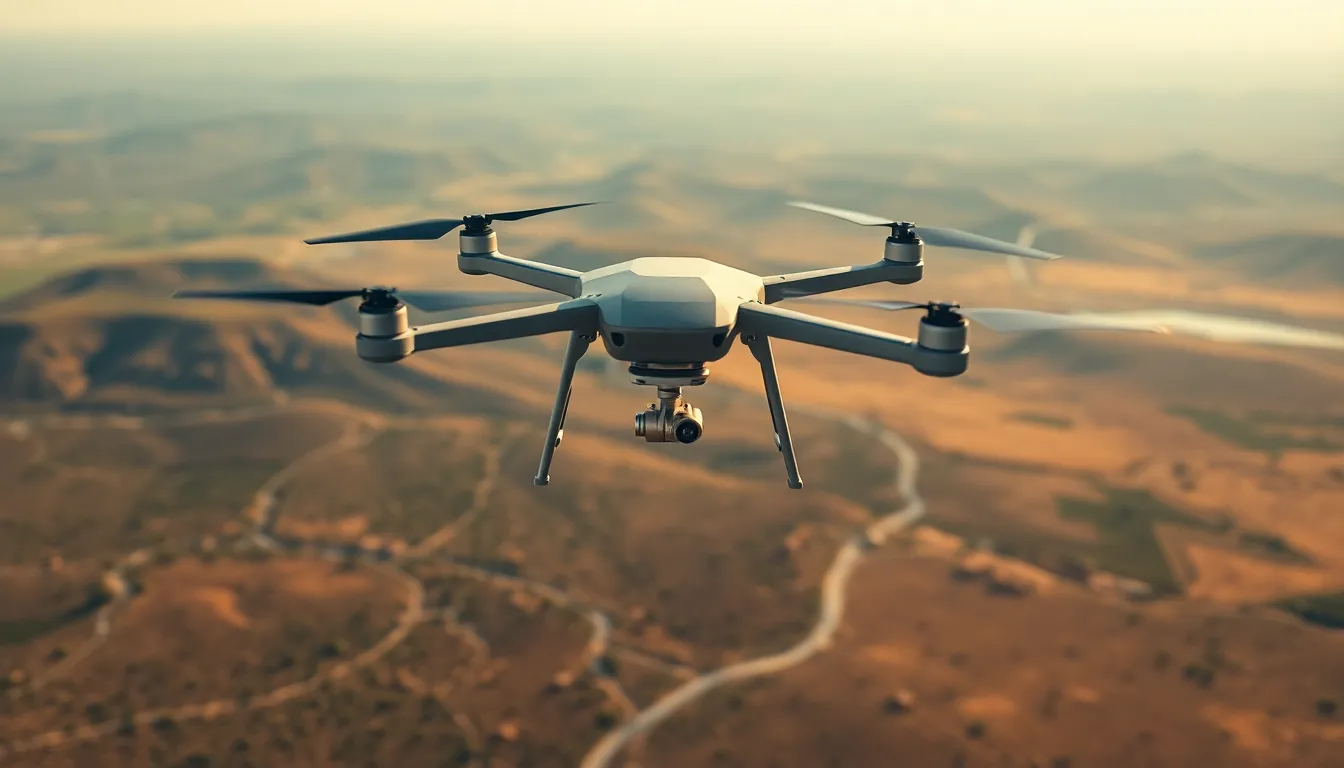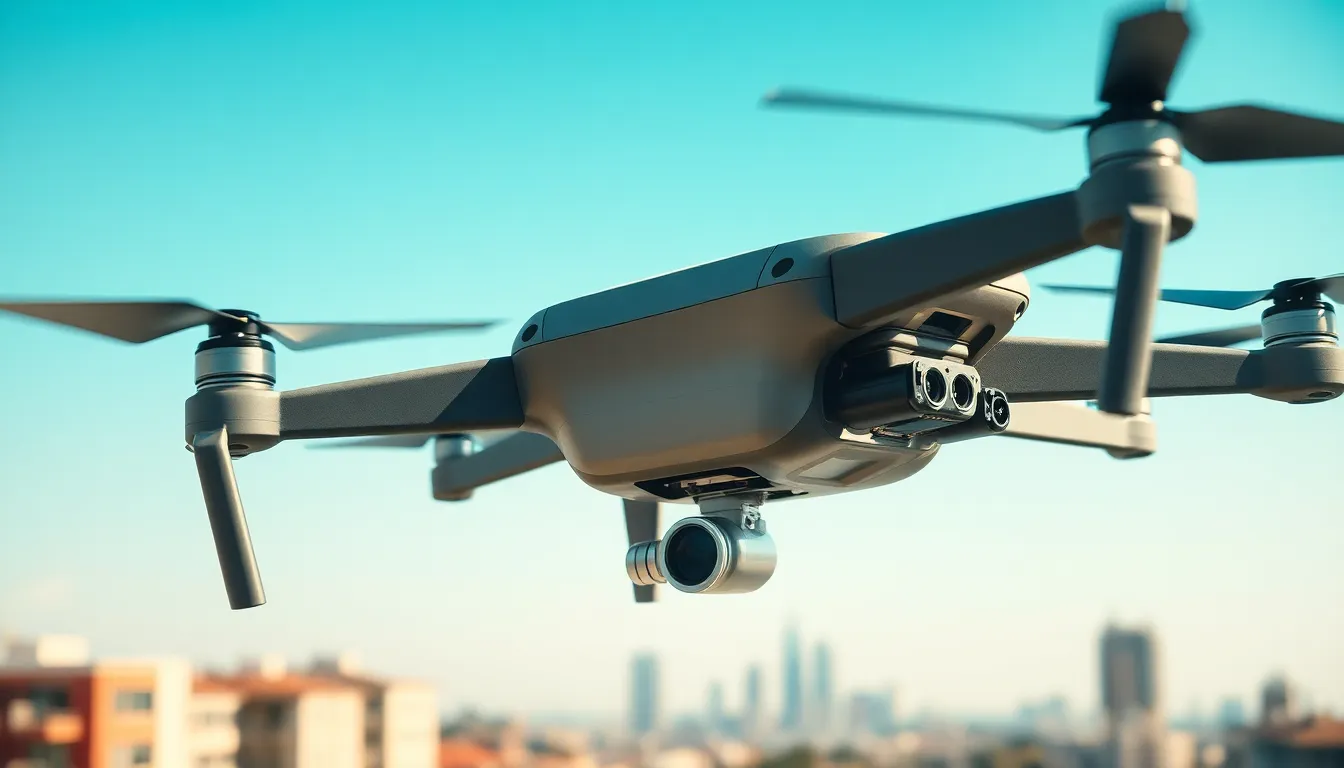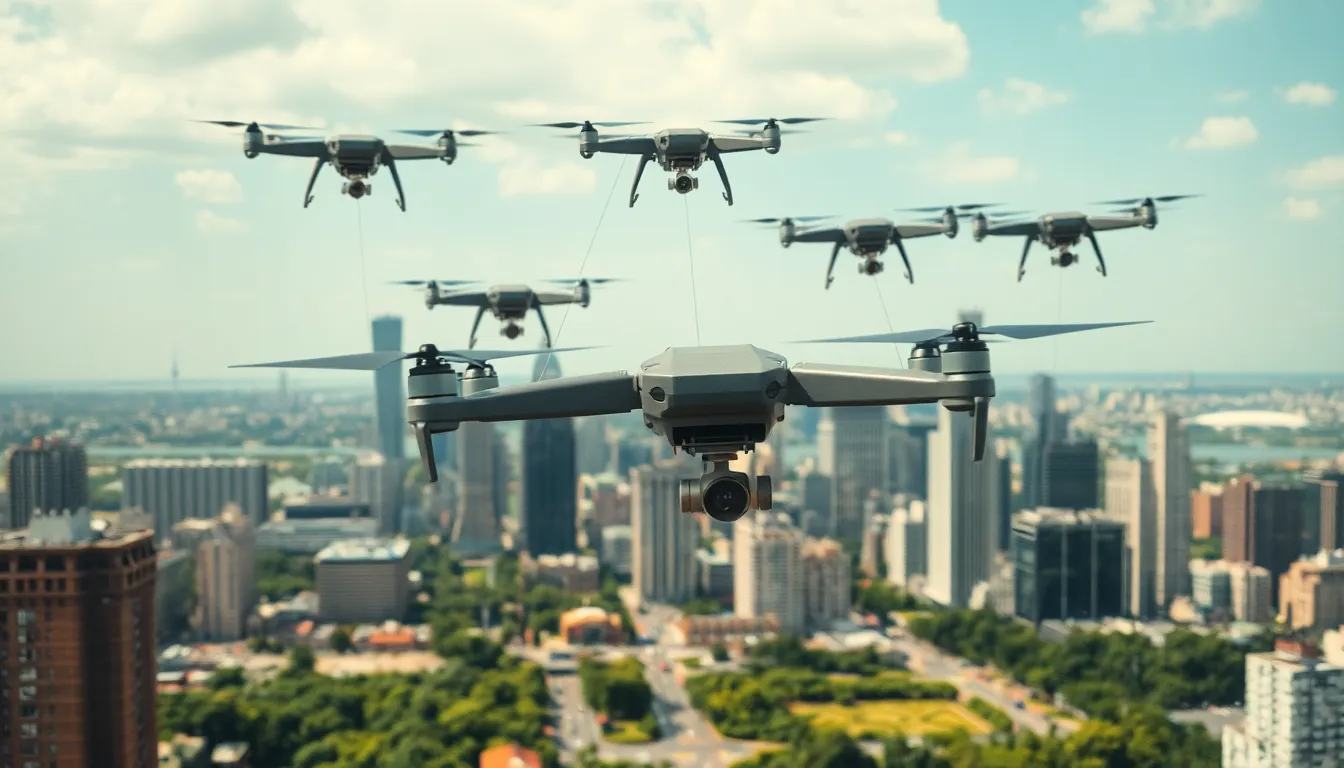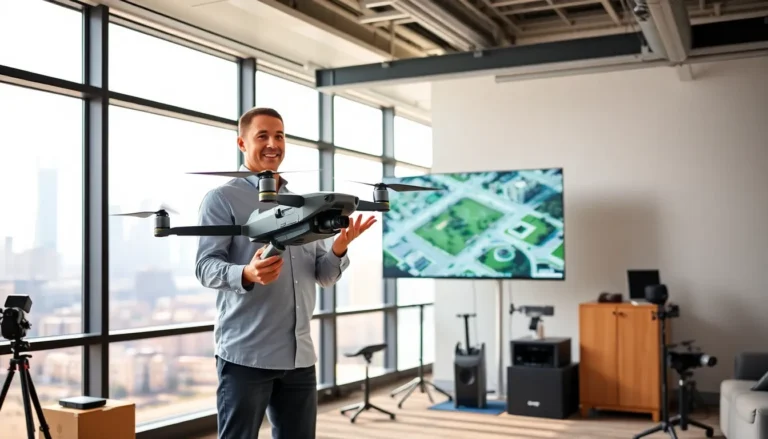In a world where drones are becoming the new superheroes of technology, their ability to communicate effectively is nothing short of a game-changer. Imagine a fleet of drones buzzing around, not just delivering packages but also chatting with each other like old friends. That’s the magic of drone communication systems. These systems allow drones to share data, avoid collisions, and coordinate missions with the precision of a well-rehearsed dance troupe.
Table of Contents
ToggleOverview of Drone Communication Systems
Drone communication systems play a crucial role in enhancing the capabilities and effectiveness of drone operations. These systems facilitate real-time data sharing, allowing drones to work together efficiently.
Importance of Communication in Drones
Effective communication in drones is essential for mission success. It enables real-time data exchange, which enhances situational awareness and decision-making. Drones equipped with communication systems can share critical information, reducing the likelihood of collisions. Coordinating activities among drones allows for streamlined operations and improved task execution, especially in complex environments such as search and rescue, surveillance, or delivery services. Thus, robust communication frameworks ensure reliability and performance, fostering advanced aerial technologies.
Types of Drone Communication Systems
Various communication systems serve the diverse needs of drones. Radio Frequency (RF) systems operate on established channels, providing stable connections with relatively low latency. Cellular networks, such as 4G and 5G, offer expansive coverage and high data transfer rates, making them suitable for urban applications. Satellite communication systems provide global reach, ideal for operations over vast areas where terrestrial networks are absent. Additionally, Mesh networks allow for decentralized communication, enhancing resilience and adaptability among fleets. Each type of system contributes to the overall functionality of drones, supporting enhanced operations in various sectors.
Key Technologies in Drone Communication


Key technologies play a crucial role in the effectiveness of drone communication systems. They provide the means for real-time interaction among drones, contributing to enhanced operational capabilities and safety.
RF Communication
RF communication serves as a foundational technology for drone operations. This system relies on radio waves to transmit information between drones and control stations. Drones equipped with RF communication can maintain a reliable link up to several miles, depending on the frequency used. Various RF bands, such as 2.4 GHz or 5.8 GHz, accommodate different applications, balancing range and data transfer rates. The simplicity of RF systems makes them popular for many commercial and hobbyist drones alike.
Satellite Communication
Satellite communication expands the operational range of drones significantly. This technology allows drones to maintain connectivity even in remote or underserved areas where traditional networks don’t reach. By utilizing geostationary satellites, drones can achieve global coverage, enabling applications like global mapping or disaster response. Data exchange occurs through uplinks and downlinks, facilitating real-time communication during missions. Satellite communication thus becomes essential for industries that rely on extensive geographic data collection.
Wireless Networks
Wireless networks, including cellular technologies like 4G and 5G, enhance drone communication features. The implementation of these networks introduces faster data transmission and improved latency. Drones integrated with 5G networks can support advanced functionalities such as high-definition video streaming and remote piloting. Lower latency ensures better control, especially during complex operations. As urban environments grow, reliance on wireless networks for drone communication continues to increase in importance, paving the way for seamless integration into smart cities.
Applications of Drone Communication Systems
Drone communication systems find utility across various sectors, significantly impacting operations and efficiency. These applications enhance collaboration and functionality, showcasing the versatility of drone technology.
Commercial Applications
Commercial sectors leverage drone communication systems for delivery services, agriculture, and infrastructure inspections. Drones improve logistics efficiency by enabling real-time data transfer between units. In agriculture, farmers utilize drones for crop monitoring, using collected data to make informed decisions on irrigation and pesticide application. Infrastructure inspections benefit from drones that can relay images and data instantly, identifying potential issues without needing human intervention, ensuring safety and reducing downtime.
Military Applications
Military forces worldwide adopt drone communication systems for intelligence, surveillance, and reconnaissance (ISR) missions. These systems allow drones to share crucial information on troop movements and enemy positions, enhancing battlefield situational awareness. Real-time communication between drones improves coordination during operations, leading to increased operational success. Additionally, drone swarms equipped with advanced communication abilities can conduct search and destroy missions, significantly enhancing tactical capabilities without risking personnel.
Research and Development
Research and development efforts revolve around improving drone communication systems to support advanced applications. Innovators focus on enhancing communication protocols, integrating artificial intelligence, and increasing system resilience. Universities and tech companies collaborate to explore new uses of drones in environmental monitoring and disaster response, relying heavily on effective communication capabilities. Moreover, ongoing research analyzes how mesh networks deliver robust connectivity for cooperative drone operations in challenging environments.
Challenges and Limitations
Drones face several challenges and limitations affecting their communication systems. Understanding these hurdles is essential for optimizing drone operations.
Signal Interference
Signal interference presents significant challenges for drone communication. Environmental factors, such as physical obstructions and electromagnetic interference, can disrupt signals. Drones operating in urban environments encounter more interference due to dense structures and competing communication devices. Additionally, weather conditions can adversely affect radio frequencies, resulting in degraded signal quality. Drones relying on cellular networks may experience connectivity issues in low-coverage areas, further complicating operations. Ensuring robust communication links demands continual assessment and advancements in technology.
Regulatory Issues
Regulatory issues significantly impact the deployment of drone communication systems. Government bodies establish rules to ensure safe drone operations, necessitating compliance. Many jurisdictions require operators to secure permits and adhere to specific communication protocols. Operating beyond visual line of sight often involves regulatory challenges that inhibit some applications. Furthermore, varied regulations across different regions complicate international operations for drone service providers. Keeping up with the evolving landscape of drone regulations demands vigilance and adaptability from drone operators.
Security Concerns
Security concerns play a critical role in drone communication systems. Unauthorized access and data breaches pose risks to sensitive information transmitted by drones. Cybersecurity threats can compromise drone operations, potentially leading to malicious hijacking and misuse. Implementing secure communication protocols is vital to protect data integrity and ensure safe operational environments. Operators must continuously update their security measures to counter emerging threats. Emphasizing security can also enhance public trust in drone technology, facilitating broader acceptance and adoption.
Future Trends in Drone Communication Systems
Drone communication systems are evolving rapidly, highlighting significant advancements that promise to enhance their functionality and integration into various sectors.
Advances in Technology
Emerging technologies redefine drone communication systems. Innovations in software protocols improve data transmission efficiency. Ubiquitous use of AI enhances decision-making capabilities while processing vast amounts of real-time data. Enhanced machine learning algorithms enable drones to adapt to dynamic environments for better performance. Additionally, developments in sensor technology contribute to improved situational awareness, allowing drones to better interpret surroundings, execute tasks, and reduce collision risks.
Integration with IoT
Integrating drones with the Internet of Things (IoT) facilitates seamless communication among devices. Drones communicate with smart devices and sensors, creating a more interconnected ecosystem. This integration enhances operational efficiency for various applications including logistics and environmental monitoring. Data collected from IoT devices enhances real-time analytics, leading to informed decision-making. Various industries benefit from this connectivity, as drone fleets interact with other systems and processes, streamlining workflows and improving overall productivity.
Enhancements in Connectivity
Improvements in connectivity are crucial for future drone operations. Advancements in 5G networks offer higher bandwidth and lower latency, significantly boosting data transmission speeds. Real-time communications become more reliable, allowing drones to operate in complex environments with ease. Enhanced connectivity technologies, such as satellite systems, expand operational ranges, enabling drones to cover larger areas efficiently. As these technologies evolve, they enhance coordination among multiple drones, improving mission success rates and operational safety across various sectors.





